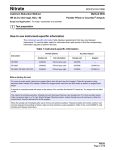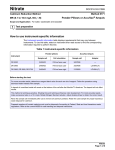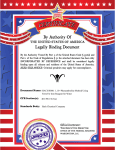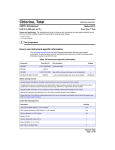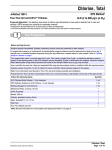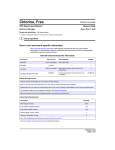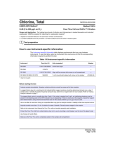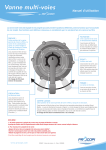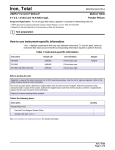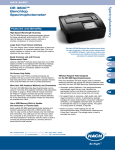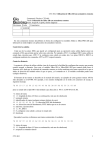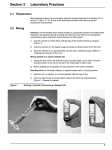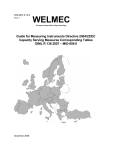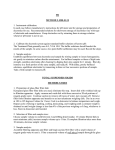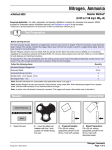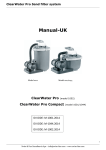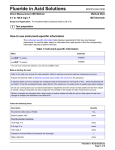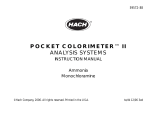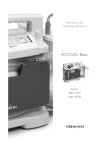Download Chlorine Dioxide - Advance Laboratorios
Transcript
Chlorine Dioxide, 10126 Chlorine Dioxide DOC316.53.01021 DPD Method1 Method 10126 Powder Pillows and AccuVac® Ampuls (0.04 to 5.00 mg/L) Scope and Application: For water and wastewater. USEPA accepted for reporting for drinking water analysis.2 1 Adapted from Standard Methods for the Examination of Water and Wastewater. 2 Procedure is equivalent to Standard Methods, 18 ed., 4500 ClO2 D. Test preparation How to use instrument-specific information The Instrument-specific information table displays requirements that may vary between instruments. To use this table, select an instrument then read across to find the corresponding information required to perform this test. Table 1 Instrument-specific information Powder pillows AccuVac Ampuls Instrument Sample cell Cell orientation Sample cell Adapter DR 5000 2495402 Fill line faces user 2427606 — DR 3900 2495402 Fill line faces user 2427606 LZV846 (A) DR 3800, DR 2800, DR 2700 2495402 Fill line faces right 2122800 LZV584 (C) Before starting the test: Analyze samples immediately because chlorine dioxide is unstable and volatile. See Sample collection, preservation and storage. For more accurate results, determine a reagent blank value for each new lot of reagent. Follow the procedure using deionized water instead of the sample. Subtract the reagent blank value from the final results or perform a reagent blank adjust. After adding the DPD Free Chlorine Powder Pillow to the sample, a pink color will develop if chlorine dioxide is present. If the chlorine dioxide concentration in the sample exceeds the upper limit of the test, the color may fade or the sample may turn yellow. Dilute the sample with high quality water that is chlorine demand-free, and repeat the test. Some loss of chlorine dioxide may occur. Multiply the result by the appropriate dilution factor. Chlorine Dioxide Page 1 of 8 Chlorine Dioxide Collect the following items: Description Quantity Powder Pillow Test: DPD Free Chlorine powder pillow, 10-mL 1 Glycine Reagent 4 drops Sample cells (see Instrument-specific information) 2 Stopper for 18 mm tube 2 AccuVac Test: DPD Free Chlorine Reagent AccuVac® Ampuls 1 Glycine Reagent 16 drops Beaker, 50-mL 1 Sample Cell (see Instrument-specific information) 1 Stopper for 18 mm tube 1 See Consumables and replacement items for reorder information. DPD method, powder pillows Stored Programs 76 Chlro Diox DPD Start 1. Select the test. Insert an adapter if required (see Instrumentspecific information). Refer to the user manual for orientation. Chlorine Dioxide Page 2 of 8 2. Blank Preparation: Fill a sample cell with 10 mL of sample. Close the sample cell. 3. Prepared Sample: Fill a second sample cell with 10 mL of sample. Close the sample cell. 4. Wipe the blank and insert it into the cell holder. Chlorine Dioxide DPD method, powder pillows (continued) Zero 5. ZERO the instrument. The display will show: 0.00 mg/L ClO2 6. Add four drops of Glycine Reagent to the sample. Swirl to mix. 7. Add the contents of one DPD Free Chlorine Powder Pillow to the prepared sample cell. Swirl the sample for 20 seconds to mix. 8. Wait 30 seconds for any undissolved powder to settle. Immediately proceed to step 9. Read 9. Within one minute of adding the DPD reagent, wipe the sample cell and insert it into the cell holder. 10. READ the results in mg/L ClO2. DPD method, AccuVac® Ampuls Stored Programs 77 Chlor Diox DPD AV Start 1. Select the test. Insert an adapter if required (see Instrumentspecific information). Refer to the user manual for orientation. 2. Blank Preparation: Fill a round sample cell with 10-mL of sample. 3. Wipe the blank and insert it into the cell holder. ZERO the instrument. The display will show: 0.00 mg/L ClO2 4. Prepared Sample: Fill a 50-mL beaker with 40 mL of sample. Add 16 drops of Glycine Reagent to the sample in the beaker. Swirl gently to mix. Chlorine Dioxide Page 3 of 8 Chlorine Dioxide DPD method, AccuVac® Ampuls (continued) Read 5. Fill a DPD Free Chlorine Reagent AccuVac Ampul with sample. Keep the tip immersed while the Ampul fills completely. 6. Quickly invert the Ampul several times to mix. Wait 30 seconds for any undissolved powder to settle. 7. Within one minute of adding the sample, wipe the Ampul and insert it into the cell holder. 8. READ the results in mg/L ClO2. Interferences Table 2 Interfering substances Interfering substance Interference level Greater than 150 mg/L CaCO3. May not develop full color or color may fade instantly. Neutralize Acidity to pH 6 –7 with 1 N Sodium Hydroxide1. Determine amount to be added on a separate sample aliquot, then add the same amount to the sample being tested. Correct for volume addition. Alkalinity pH 6–7 with 1 N Sulfuric Acid1. Determine amount to be added on a separate sample aliquot, then add the same amount to the sample being tested. Correct for the volume addition. Bromine, Br2 Interferes at all levels. Chlorine, Cl2 May interfere at levels greater than 6 mg/L. Additional glycine may be able to compensate for this interference. Chloramines, organic May interfere. Flocculating agents High levels of most flocculating agents can be tolerated. This tolerance is decreased if chlorine is present. See the information about metals in this table. In the presence of 0.6 mg/L Cl2, Al(SO4)3 (< 500 mg/L) and FeCl2 (<200 mg/L) may be tolerated. Hardness No effect at less than 1000 mg/L as CaCO3. Iodine, I2 Interferes at all levels. Greater than 250 mg/L CaCO3. Color may not develop fully or may fade instantly. Neutralize to Oxidized manganese interferes at all levels. Oxidized chromium interferes at levels greater than 2 mg/L. To remove the interferences: 1. Adjust sample pH to 6–7. Manganese, oxidized (Mn4+, Mn7+) or Chromium, oxidized (Cr6+) Chlorine Dioxide Page 4 of 8 2. 3. Add 3 drops Potassium Iodide1 (30 g/L) to a 25-mL sample. Mix and wait one minute. 4. 5. 6. Add 3 drops Sodium Arsenite1, 2 (5 g/L) and mix. Analyze 10 mL of the treated sample as described in the procedure. Subtract the result of this test from the original analysis to obtain the correct chlorine dioxide concentration. Chlorine Dioxide Table 2 Interfering substances (continued) Interfering substance Interference level Metals Various metals may interfere by combining with the glycine needed to remove the chlorine interference. Metal interference is limited except when chlorine is present. In the presence of 0.6 mg/L Cl2, both copper (>10 mg/L) and nickel (>50 mg/L) interfere. Other metals may also interfere, depending on their ability to prevent glycine from reacting with any Cl2 in the sample. It may be necessary to add more glycine to overcome this interference. Monochloramine Causes a gradual drift to higher readings. When read within 1 minute after reagent addition, 3 mg/L monochloramine causes less than a 0.1 mg/L ClO2 increase in the reading. Ozone Interferes at levels greater than 1.5 mg/L. Peroxides May interfere. Extreme sample pH Adjust to pH 6–7. Highly buffered samples Adjust to pH 6–7. 1 See Optional reagents and apparatus. 2 Samples treated with sodium arsenite for interferences will be hazardous waste as regulated by Federal RCRA for arsenic (D004). Refer to a current MSDS for proper disposal instructions. Sample collection, preservation and storage Analyze samples for chlorine dioxide immediately after collection. Chlorine dioxide is a strong oxidizing agent and is unstable in natural waters. It reacts rapidly with various inorganic compounds, but oxidizes organic compounds more slowly. Many factors, including reactant concentrations, sunlight, pH, temperature, and salinity influence decomposition of chlorine dioxide in water. Avoid plastic containers since these may have a large chlorine dioxide demand. Pretreat glass sample containers to remove any chlorine or chlorine dioxide demand by soaking in a dilute bleach solution (1 mL commercial bleach to 1 liter of deionized water) for at least one hour. Rinse thoroughly with deionized or distilled water. If sample containers are rinsed thoroughly with deionized or distilled water after use, only occasional pretreatment is necessary. A common error in testing for chlorine dioxide is not obtaining a representative sample. If sampling from a tap, let the water flow for at least 5 minutes to ensure a representative sample. Let the container overflow with the sample several times, then cap the sample containers so there is no headspace (air) above the sample. If sampling with a sample cell, rinse the cell several times with the sample, then carefully fill to the 10-mL mark. Perform the chlorine dioxide analysis immediately. Accuracy check Standard Solution Method Preparing chlorine dioxide standards is difficult and dangerous. In addition, these standards are both explosive and volatile! Only a trained chemist should prepare the standards using appropriate safety equipment and precautions. The manufacturer does not recommend preparation of chlorine dioxide standards. If independent standard preparation is required, please see the instructions in Standard Methods for the Examination of Water and Wastewater, Part 4500-ClO2 Chlorine Dioxide, under the headings "Stock chlorine dioxide solution" and "Standard chlorine dioxide solution". Prepare a chlorine dioxide standard. Chlorine Dioxide Page 5 of 8 Chlorine Dioxide Method performance Program Instrument Standard Precision 95% Confidence Limits of Distribution Sensitivity Concentration change per 0.010 Abs change 76 DR 5000 3.00 mg/L ClO2 2.89–3.11 mg/L ClO2 0.04 mg/L ClO2 77 DR 5000 3.00 mg/L ClO2 2.91–3.09 mg/L ClO2 0.04 mg/L ClO2 Summary of method Chlorine dioxide reacts with DPD (N, N-diethyl-p-phenylenediamine) to the extent of one-fifth of its total available chlorine content, corresponding to reduction of chlorine dioxide to chlorite. The resulting pink color intensity is proportional to the ClO2 in the sample. Chlorine interference is eliminated by adding glycine, which converts free chlorine to chloroaminoacetic acid, but has no effect on chlorine dioxide at the test pH. Test results are measured at 530 nm. Consumables and replacement items Required reagents Description Quantity/Test Unit Catalog number 1 100/pkg 2105569 4 drops 29 mL 2762133 Chlorine Dioxide DPD/Glycine Reagent Set (100 tests), includes: (1) DPD Free Chlorine Reagent Powder Pillows, 10-mL (1) Glycine Reagent 2770900 OR 2771000 Chlorine Dioxide DPD/Glycine AccuVac® Ampul Reagent Set (25 tests), includes: (1) DPD Free Chlorine Reagent AccuVac® Ampuls (1) Glycine Reagent 1 25/pkg 2502025 16 drops 29 mL 2762133 Quantity Unit Catalog number Required apparatus Description AccuVac Snapper 1 each 2405200 Beaker, 50-mL 1 each 50041H Stopper for 18 mm tube 1 6/pkg 173106 Sample cell, 10 mL round, 25 x 54 mm 1 each 2122800 Sample cell, 10 mL round, 25 x 60 mm 1 6/pkg 2427606 Sample cell, 10 mL square, matched pair 2 2/pkg 2495402 Recommended standards Description Chlorine Standard Solution, 10-mL Voluette® Ampule, 50–75 mg/L Voluette Ampule Breaker, for 10-mL ampules Water, organic-free Chlorine Dioxide Page 6 of 8 Unit Catalog number 16/pkg 1426810 each 2196800 500 mL 2641549 Chlorine Dioxide Optional reagents and apparatus Description AccuVac Vials, for sample blanks Unit Catalog number 25/pkg 2677925 DPD Free Chlorine Reagent Powder Pillows, 10-mL 1000/pkg 2105528 DPD Free Chlorine Reagent Powder Pillows, 10-mL 300/pkg 2105503 Potassium Iodide, 30 g/L 100 mL 34332 Sodium Arsenite, 5 g/L 100 mL 104732 Sodium Hydroxide, 1 N 100 mL 104532 each 2270800 25/pkg 173125 each 127032 Standard Methods Book, most current edition Stopper for 18 mm tube Sulfuric Acid, 1 N, 100 mL Chlorine Dioxide Page 7 of 8 FOR TECHNICAL ASSISTANCE, PRICE INFORMATION AND ORDERING: In the U.S.A. – Call toll-free 800-227-4224 Outside the U.S.A. – Contact the HACH office or distributor serving you. On the Worldwide Web – www.hach.com; E-mail – [email protected] © Hach Company, 2007, 2010. All rights reserved. Printed in the U.S.A. HACH COMPANY WORLD HEADQUARTERS Telephone: (970) 669-3050 FAX: (970) 669-2932 Edition 6








